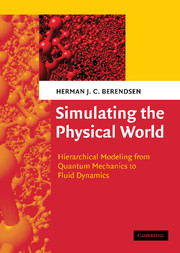Book contents
- Frontmatter
- Contents
- Preface
- Symbols, units and constants
- Part I A Modeling Hierarchy for Simulations
- 1 Introduction
- 2 Quantum mechanics: principles and relativistic effects
- 3 From quantum to classical mechanics: when and how
- 4 Quantum chemistry: solving the time-independent Schrödinger equation
- 5 Dynamics of mixed quantum/classical systems
- 6 Molecular dynamics
- 7 Free energy, entropy and potential of mean force
- 8 Stochastic dynamics: reducing degrees of freedom
- 9 Coarse graining from particles to fluid dynamics
- 10 Mesoscopic continuum dynamics
- 11 Dissipative particle dynamics
- Part II Physical and Theoretical Concepts
- References
- Index
4 - Quantum chemistry: solving the time-independent Schrödinger equation
Published online by Cambridge University Press: 05 June 2012
- Frontmatter
- Contents
- Preface
- Symbols, units and constants
- Part I A Modeling Hierarchy for Simulations
- 1 Introduction
- 2 Quantum mechanics: principles and relativistic effects
- 3 From quantum to classical mechanics: when and how
- 4 Quantum chemistry: solving the time-independent Schrödinger equation
- 5 Dynamics of mixed quantum/classical systems
- 6 Molecular dynamics
- 7 Free energy, entropy and potential of mean force
- 8 Stochastic dynamics: reducing degrees of freedom
- 9 Coarse graining from particles to fluid dynamics
- 10 Mesoscopic continuum dynamics
- 11 Dissipative particle dynamics
- Part II Physical and Theoretical Concepts
- References
- Index
Summary
Introduction
As has become clear in the previous chapter, electrons (almost) always behave as quantum particles; classical approximations are (almost) never valid. In general one is interested in the time-dependent behavior of systems containing electrons, which is the subject of following chapters.
The time-dependent behavior of systems of particles spreads over very large time ranges: while optical transitions take place below the femtosecond range, macroscopic dynamics concerns macroscopic times as well. The light electrons move considerably faster than the heavier nuclei, and collective motions over many nuclei are slower still. For many aspects of long-time behavior the motion of electrons can be treated in an environment considered stationary. The electrons are usually in bound states, determined by the positions of the charged nuclei in space, which provide an external field for the electrons. If the external field is stationary, the electron wave functions are stationary oscillating functions. The approximation in which the motion of the particles (i.e., nuclei) that generate the external field, is neglected, is called the Born–Oppenheimer approximation. Even if the external field is not stationary (to be treated in Chapter 5), the non-stationary solutions for the electronic motion are often expressed in terms of the pre-computed stationary solutions of the Schrödinger equation. This chapter concerns the computation of such stationary solutions.
Thus, in this chapter, the Schrödinger equation reduces to a time-independent problem with a stationary (i.e., still time-dependent, but periodic) solution. Almost all of chemistry is covered by this approximation.
- Type
- Chapter
- Information
- Simulating the Physical WorldHierarchical Modeling from Quantum Mechanics to Fluid Dynamics, pp. 77 - 108Publisher: Cambridge University PressPrint publication year: 2007



